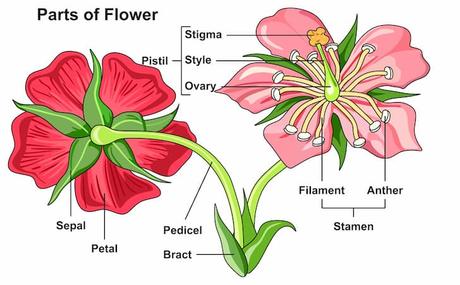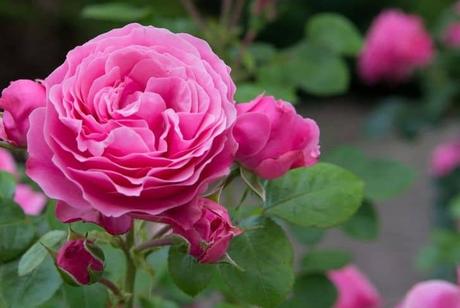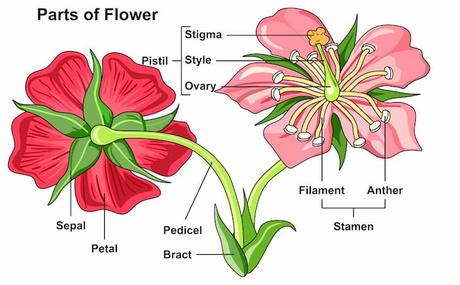If you’re a true connoisseur of flowers and plants, roses might as well be one of your top favorites. Indeed, the rose does reign over its contemporaries when it comes to beauty, style, and even fragrance. Often touted to be the ‘Queen of Flowers’, roses have been in the picture for several million years.
As you’d probably guess, they have multiple species like Grandiflora, climbing, hybrid, French, Damask, and so many more. But what exactly are the different parts of a rose plant? Do rose leaves come with any benefits? What are the uses of red rose? Well, we have done some research, and in this article, we will discuss all of your burning questions. So, if you are looking to plant roses in your home garden, here are some of the vital things you need to know about.

The Different Parts of a Rose Flower Plant
The two primary parts of the Rose plant are the stamen and the pistil which are the male and female components respectively. Other parts include petals, leaves, and sepals. In this section, we will discuss these parts and sub-parts in detail.
Stamen
This is the male reproductive component of the rose it includes the filament and the anther. While the filament appears like a stalk and is attached to the plant’s base, the anther is the sticky part right above the stigma.
Pistil
This is the female reproductive component found in the middle of the rose flower. It features the ovary (the reproductive system of the flower), style (a tube-like structure connecting the ovary to the stigma), and the stigma which is right above the pistil. The components of the pistil are collectively known as the carpel.
Petals
Also known as the blooms, these petals usually consist of cellulose and a range of additional materials. The petals are collectively termed as the corolla.
Sepals
These are the green foliage right around the flower and their primary role is to safeguard the petals and the delicate buds.
Leaves
Right above the foliage, the leaves are best known for facilitating photosynthesis in the plant. Most leaves contain a range of pores, known as stomata.
Stipule
Appearing like wings, you will find the stipules right at the base of the rose. They are known to safeguard the buds while also creating energy for the delicate plant. The upper part of the stipule is called the Auricle.
Stems
Found both above the surface and underground, the stems of the rose plants come in multiple lengths, depending on their specific classes.
Peduncles
These are the soft and almost wooded parts of the stem with an almost leaf-like structure.
How Many Leaves Does a Rose Have?
The modern hybrid rose comes with 5 leaves and a singular flower. However, you will find other roses belonging to multiple categories featuring 7 and in some cases 9 leaflets. These leaflets tend to be greener and paler with remarkably fewer thorns. If you are planning to plant roses for the first time, it is worth checking the number of leaves to specifically ensure that you are indeed investing in roses.
What Are the Characteristics of a Rose?
Roses are beautiful flowers that are loved by almost all gardeners. However, if you are planning to grow them at home, it is important to understand their many characteristics. In this section, we will discuss the characteristics of roses in detail.
1. Symmetrical
Roses feature flower heads that are completely round in shape. The biggest highlight of the flowers, however, is the symmetry. Every rose symmetrically along the face right until the vertical axis. The flower gradually emerges from a primary central ovary that is found in the middle of the bloom right below the petals and in the middle of the sepals. Regardless of the number, the petals of all roses are known for their even distribution along with the ovary and the stamens.
2. Petals
The petals of roses are available in varying shapes. While some appear like cones, others take the shape of a tear. While some ate flat, others curl up around the edges. Most roses can feature 5 to 60 petals that overlap along with the flower heads. Although the color and the total number of these petals tend to vary, their texture is almost similar. These petals have an excellent texture with multiple veins. They are also super-cool and extremely smooth. Their naps are silky and soft.
3. Hue
Roses are available in a wide range of hues. In some instances, you will find them in multiple shades of one specific color. Rose petals are either bi or tri-colored and they bloom in almost every color barring black. Certain hybrids of roses can come up with beautiful blooms with speckle or striped petals.
4. Fragrance
Popular for their rich and spicy scent, many people consider growing roses for their stunning fragrance alone. However, of late, several species of roses, especially the modern ones do not come with the conventional rose-like aroma. While these variants of rose are also scented, they are nothing like the heady fragrance of your garden-variety rose. If your rose has a bigger bloom head and is thick and velvety, it will probably produce a stronger and more pertinent scent.
What is the Use of Rose Leaves?
Rose leaves are primarily used for medicinal purposes. They are combined with the hips and flowers of rose to create a concoction that can treat a range of ailments. That is probably the reason why you will find the reference to these specific plant parts in almost all books of herbal medicine.
According to multiple chemists, medicine experts during the medieval era used to sell Turkish Petals as a cure for toothache. Interestingly, these petals weren’t rose petals, instead, they were rose leaves that were mixed with gum for creating attractive black pills. Many experts claim that these pills cured toothache and a range of other inflammatory issues.
It is also known that the leaves of Rosa Pomifera, a species of rose was used for creating an infusion known as the German tea. This was further enhanced with the barks and the seeds of rose. While the exact benefit of the German tea is not known, many believe that it comes with calming properties.

What Are the Uses of Red Rose?
If you thought red roses were only meant for gifting, think again! Roses come with many uses and, in this section, we will discuss just a few of the major and common uses.
1. Preparing Scents and Scented Products
This is probably the most common use of the red rose. The flower is primarily used for preparing perfumes and a range of other scented items. Rose is widely chosen for this task because of its naturally beautiful aroma. That is also the reason why you will find multiple rose-scented perfumes and room fresheners across the globe.
The scent of the red rose functions like a tranquilizer and most of the time it also boosts mood. When used the right way, this scent can also enliven your atmosphere with a soft and almost sensual appeal. So, next time you use your rose-scented perfume, you know where the scent came from!
2. Skin and Haircare
If acne and hair fall are your major issues, the red rose might just be your best friend. Dry petals of red rose and distilled water are known to be an excellent face mask. This doesn’t just cleanse your skin but also opens the closed pores.
Red rose is also used for manufacturing rose oil which in turn nourishes your scalp, thereby boosting hair growth and regenerating your hair follicles. In some instances, oil infused with red rose extracts may be also used in aromatherapy. This adds to your relaxation while also lifting your mood. The extracts of these flowers are also used for preparing a range of creams, body lotions, soaps, and the likes of them.
Even the basic rose water comes with multiple benefits. Not only does it nourishes your skin but it may also be used for treating a range of skin issues like dermatitis, eczema, and flaky skin. Since rose water also comes with many astringent-like elements, one may even apply it right before adding makeup to prevent the secretion of oil which further helps your cosmetics last longer.
The best part: rose is anti-inflammatory, which means you can comfortably use rose-based cosmetics regardless of your skin type. When used the right way, it will effectively treat your skin and hair while also eliminating toxins from your body.
3. Culinary Delights
The uses of red rose aren’t just restricted to cosmetics- you can also use it for preparing delicious meals. Red rose is used for manufacturing a range of culinary products like syrups, essences, jams, and other flavoring agents.
The hips of the red rose are the tangiest part since it renders a perfectly fruity flavor akin to cranberries. You might want to consume them fresh, though they can also be dried and preserved. Crushed hips of the red rose are used for preparing different types of herbal teas. These teas don’t just help you relax, but they also set the mood and reduce anxiety.
Red rose extracts are also used for flavoring candies, rose base syrups, and other kinds of desserts. Petals from the red rose can be further used to prepare a range of desserts. Thanks to its fragrance and non-toxic properties, rose is completely safe to consume. Since it also contains copious doses of Vitamin C, the red rose will also boost your health.
4. Medicinal Uses
As with the rose hips, the red rose also comes with multiple medicinal uses. The flower is a certified antiseptic with antioxidants, and multiple vitamins like A, B3, C, and D. Products manufactured from red roses are known to have calming effects that are especially useful to relieve anxiety. Rosewater further goes the extra mile in relaxing nerve tensions and cutting down on the swelling of capillaries under your skin.
Tea prepared from rose petals helps to secrete bile juices that play a vital part in the cleansing of the gall bladder. The tea is equally useful when it comes to reducing fever and bronchial infections. The best part: it boosts and ensures blood circulation.
Multiple eye products come with rose water because of its cooling effect. The water is also known to reduce eye inflammation.
Finally, essential oils derived from red rose may be used for treating more serious ailments like ulcers, fatigue, colon infection, and the likes. It also happens to be an excellent agent when it comes to treating runny nose and throat issues.
While you can always plant your rose and enjoy its beauty, understanding and identifying the different parts of this stunning flower will only add to your enjoyment. So, wait no further, and start embracing your beautiful rose bushes and make the most of the flowers and leaves.


